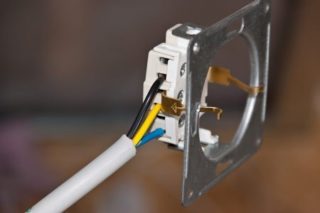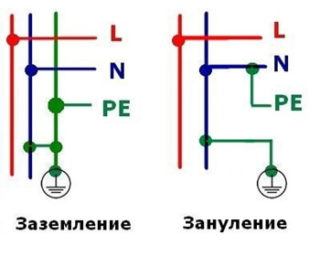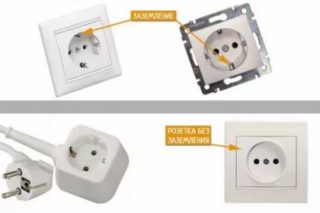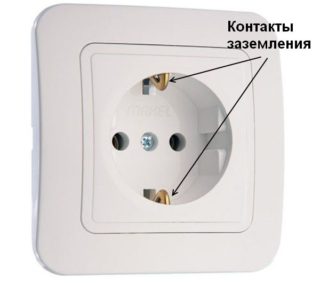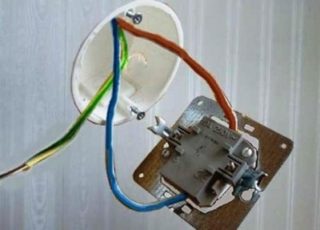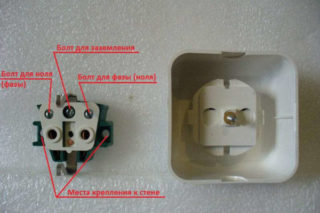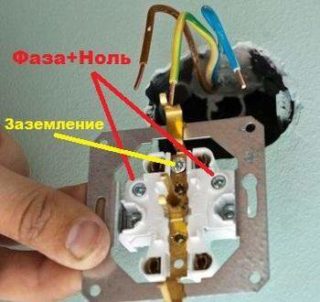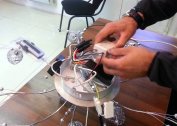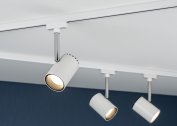Thanks to electricity in the houses there is light, water and heating, people have the opportunity to use a variety of household appliances, which significantly increase the quality of life. At the same time, the current poses a huge danger if an emergency occurs during the operation of machinery and equipment connected to the circuit. Eliminate the risk of electric shock by a properly installed outlet with grounding. In order to correctly and safely perform installation, you do not need professional skills and devices. A set of home tools and basic knowledge in the field of physics is enough.
What is grounding?
An electric current is a stream of electrons moving along a conductor under the influence of a magnetic field that creates a potential difference. By the nature of substances, particles move from a positive potential (+), which is called a phase, and is fed to a technique, to a negative (-) called zero. A man, 70% water, is an ideal conductor of current. Earth has an absolute zero potential. If there is a separate line and a deepened contour, it will take on both leakage and static charge, which will go along the path of least resistance bypassing the human body.
What role does
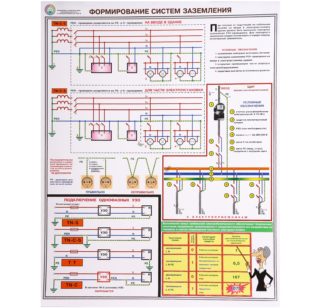 In accordance with the updated GOST, all private houses and apartments must be equipped with grounded sockets with special contacts for the wire, which receives current leakage in the devices. Many do not attach importance to this decision and in vain. In household appliances, internal wires often go off or burn out, after which they touch the housing. An earthed socket with earthing picks up voltage from the surface of the equipment, diverting it in a separate line to the structure buried in the ground. The resistance of this line is less than that of the human body. This eliminates the possibility of accidents due to faulty wiring of household appliances. In this way, a socket for covert wiring with grounding reduces the leakage current to a safe level.
In accordance with the updated GOST, all private houses and apartments must be equipped with grounded sockets with special contacts for the wire, which receives current leakage in the devices. Many do not attach importance to this decision and in vain. In household appliances, internal wires often go off or burn out, after which they touch the housing. An earthed socket with earthing picks up voltage from the surface of the equipment, diverting it in a separate line to the structure buried in the ground. The resistance of this line is less than that of the human body. This eliminates the possibility of accidents due to faulty wiring of household appliances. In this way, a socket for covert wiring with grounding reduces the leakage current to a safe level.
What is the difference between grounding and grounding
Not all housing stocks have grounding in outlets. However, there is a need to protect residents from electric shock when using household appliances, especially those that are equipped with a steel case and installed in humid rooms. To do this, use grounding - connecting the body of the electrical installation to the neutral wire. In its intended purpose, this solution performs a protective function - preventing a person from getting a leakage current.
The difference with grounding is that in the case of grounding when current is pushed to the body, a short circuit occurs, which leads to the operation of automatic devices installed both on the line and in the device itself. The defeat of a person is excluded initially, since a broken device will be de-energized even before it comes into contact with it. You can connect it to the network only after troubleshooting.
Distinctive features of a ground outlet
In order not to make a mistake when making a purchase, you need to know what a socket with a grounding contact looks like. In appearance, it practically does not differ from analogues with phase and zero. The product cover is white, black or brown.The module can be single or double with connectors for plugs with a diameter of 3.6 mm.
Modules have the following technical characteristics:
- voltage - 220-250 V;
- current strength - 8 A, 16 A;
- power - 3.6 kW, 7.2 kW;
- fastening - internal and external.
Some models are equipped with stabilizers with an indicator display and an emergency shutdown device.
The external difference of grounding outlets is the presence on the sides of the socket of metal springs that are in contact with the plug terminals. The springs are brought to the third contact located between the phase and zero, to which the grounding cable is connected.
When it is forbidden to connect grounding to outlets
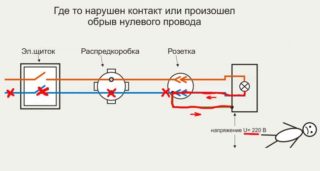 There are a number of rules regarding the safety of electrification of premises. Their violation can mean only one thing - creating a situation fraught with electric shock to people.
There are a number of rules regarding the safety of electrification of premises. Their violation can mean only one thing - creating a situation fraught with electric shock to people.
It is forbidden to connect the socket of the hidden wiring to ground in the following cases:
- Damage or rupture of a wire leading to a steel frame buried in the ground.
- The presence of a jumper between the ground and the ground line.
- Conclusion of the third wire to house communications - water, gas or heating pipes.
Connecting is possible only after eliminating defects in the wiring.
How to choose the right outlet
To choose the right socket, you need to study and evaluate a number of factors that will affect its reliability and functionality.
You should focus on such criteria:
- Type of metal. The best features are stainless steel parts.
- Power. A good option is a two-socket device at 16 A.
- Body material. It is better to focus on ceramics that are resistant to heat and corrosion.
- A type. If you put the indoor unit, you can save space. An open way saves time and effort.
When choosing, every little thing matters, including the color and design of the product.
Mounting a ground outlet
Installation must be carried out in a de-energized room with protective gloves and glasses.
To work, you will need:
- multimeter;
- screwdriver;
- steel rails;
- pliers;
- nippers;
- knife;
If you need to hide the cable into the wall, you need a grinder and a punch. Work should be standing on a dielectric mat.
How to find out if there is grounding in the outlet
Installing a socket with three contacts makes sense only if it is connected to the ground loop. You can determine this in several ways that are accessible even to a beginner.
- Visually check the connection of the third yellow-green wire.
- Measure the resistance between phase and earth. If it is, a connection is available.
- Connect the wires from the lamp in the socket. Its burning is evidence of the integrity of the line and the health of the circuit.
Indirect signs of a lack of grounding are crackling in the speakers and weak electric shocks from operating devices with a steel casing.
Installing an invoice option
Overhead points are installed on the walls of solid wood, drywall and plywood.
The sequence of actions is as follows:
- Mark the place of fastening of the socket and cable.
- Lead the wires.
- Disassemble the device housing, loosen the bolts.
- Strip and connect the conductors to the contacts.
- Screw the base to the surface.
- Assemble the socket, check the strength of its fixation.
Open wiring can be hidden in pipes, plastic channels, put on strings or insulators.
Connecting an internal option
Before connecting a three-wire cable with grounding to an outlet, you need to check its integrity. It should not have external damage, creases and melted areas.
The work is performed in the following order:
- Mark up.
- Make the strobes and the hole for the mounting box.
- Remove dust and crumbs from the openings, treat the walls with a primer.
- Lay the cable, leading it out of the hole 15-20 cm.
- Enamel the installation box. It must be placed on the same level with the wall.
- Connect the wires to the contacts.
- Secure the device with screws and extendable feet.
After that, you can supply electricity to the room.
Wire connection
The stability of the device depends on the correct connection of the wires. It should be remembered that copper tends to oxidize over time, which reduces the quality of contacts. To avoid this, the ends of the wires freed from insulation by 10 mm are soldered. After that, they must be inserted into the holes as far as they will go and pressed as tightly as possible with bolts. The reliability of fixation is checked by lightly pulling on the wires.
Checking the connection
After installation and before applying electricity, it is necessary to check the correct connection.
This procedure consists of monitoring the following elements:
- mounting box;
- matching wires and terminals;
- line to loop integrity;
- housing fastening strength;
- reliability of fixing the cover.
If there are additional options in the enclosure, they must be connected to the phase.
Double outlet
Installation of the device with two sets of connectors is practically no different from the installation of single products. The contacts are connected in one common circuit, which diverts the leakage current from both consumers, regardless of where they are connected. At the same time, it should be noted that the current strength indicated on the cover is the total for both installations.
The only difference is the size of the mounting box. Depending on the design of the product, it can also be double. The opening is made by drilling holes or sawing rectangular openings in the wall. Connection is carried out in the usual way.
The main mistakes in the manufacture of the grounding circuit
The most common installation errors:
- lack of electrodes connecting the frame to the ground;
- the use of excessively small products that are unable to accept leakage current;
- the use of bolted and welding joints not treated with paint or sealant;
- Insulation of copper cable of insufficient cross-section.
Errors can be avoided if you first familiarize yourself with the requirements for connecting electrical installations.
